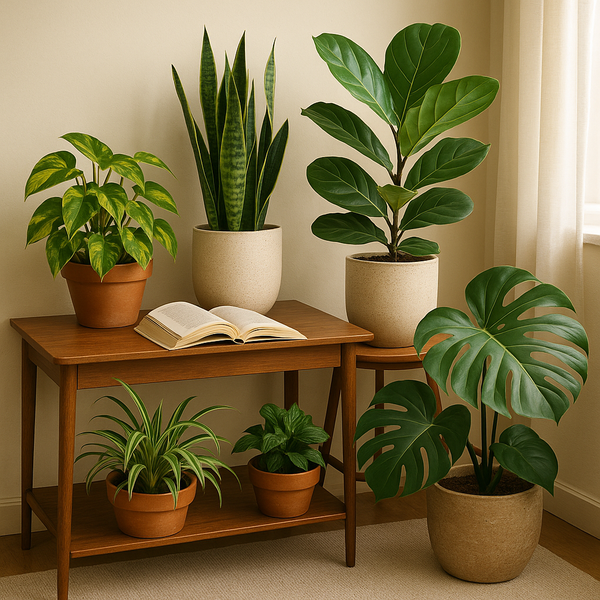
Bringing the outdoors in with vibrant indoor plants transforms any space into a serene retreat. However, many plant enthusiasts find that keeping their leafy companions happy and healthy can be a bit of a mystery. While houseplants offer numerous benefits, from improving air quality to boosting mood, they each have unique needs. Understanding the fundamentals of indoor plant care is the first step towards cultivating a thriving indoor jungle rather than just surviving specimens.
Understanding Your Plant's Needs
Before you even bring a plant home, it's crucial to understand its basic requirements. Different plants thrive in different environments. Light, water, humidity, temperature, and soil are the primary factors influencing a plant's health. A little research beforehand can save you a lot of heartache (and dead leaves) later on. Consider the conditions in your home: Do you have bright, sunny windows or mostly low-light areas? Is your home consistently warm, or does the temperature fluctuate? Knowing your home's environment will help you choose plants that are likely to flourish there.
Light: The Energy Source
Light is arguably the most critical factor for indoor plants, as it's essential for photosynthesis. Plants are often categorized by their light needs: high light, medium light, and low light. High-light plants, like succulents and cacti, need direct sunlight for several hours a day, typically from a south or west-facing window. Medium-light plants, such as many ferns and pothos, prefer bright, indirect light, often found a few feet away from a sunny window or in an east-facing window. Low-light plants, like snake plants and ZZ plants, can tolerate dimmer conditions, but even they benefit from some ambient light. Placing a low-light plant in a perpetually dark corner is a recipe for decline. Observe your plants; stretching stems and small, pale leaves can indicate insufficient light.
Watering Wisdom
More houseplants are killed by overwatering than underwatering. Proper watering technique is key. The best way to determine if your plant needs water is to check the soil moisture. Stick your finger about an inch or two into the soil. If it feels dry, it's likely time to water. If it's still moist, wait a few days and check again. Factors like pot size, plant type, soil mix, temperature, and humidity all affect how quickly soil dries out. Always use pots with drainage holes to prevent water from sitting and causing root rot. When you water, water thoroughly until excess water drains from the bottom. Discard any water collected in the saucer after about 30 minutes to prevent the roots from sitting in standing water.
The Right Soil and Potting
Using the correct potting mix is vital. Standard garden soil is too dense for pots and can compact, hindering drainage and root growth. Use a high-quality potting mix designed for containers. Some plants, like cacti and succulents, require a mix formulated for drainage, while others, like ferns, prefer a mix that retains more moisture. Repotting is necessary when a plant outgrows its current container (you'll see roots circling the bottom or emerging from drainage holes) or when the soil has become compacted and isn't draining well. Choose a new pot only one or two inches larger in diameter than the old one. Repotting gives the plant fresh nutrients and room to grow.
Humidity and Temperature Control
Most indoor plants originate from tropical environments and thrive in higher humidity than typical homes provide, especially during winter months with heating systems running. Signs of low humidity include brown, crispy leaf edges. You can increase humidity by misting your plants regularly (though this is often temporary), placing pots on pebble trays filled with water (ensure the pot sits on the pebbles, not in the water), grouping plants together, or using a humidifier. Maintain a consistent temperature; most houseplants prefer temperatures between 65-75°F (18-24°C) during the day and slightly cooler at night. Avoid placing plants near drafty windows, heating vents, or air conditioners.
Feeding Your Plants
While light and water are crucial, plants also need nutrients. Potting soil contains some nutrients, but they eventually get depleted. Fertilizing during the active growing season (typically spring and summer) provides plants with the food they need to thrive. Use a balanced liquid fertilizer diluted to half strength or a slow-release fertilizer. Avoid fertilizing during fall and winter when most plants are dormant. Over-fertilizing can burn roots and damage the plant.
Dealing with Pests and Diseases
Even with the best care, houseplants can occasionally fall victim to pests like spider mites, mealybugs, aphids, or fungus gnats, or diseases like fungal spots. Inspect your plants regularly for any signs of trouble. Early detection is key. Isolate affected plants to prevent pests from spreading. Many common pests can be treated with insecticidal soap, neem oil, or rubbing alcohol on a cotton swab. Ensure good air circulation and avoid overwatering to prevent many fungal issues. Keeping plants healthy through proper care is the best defense against pests and diseases.
Pruning and Propagation
Pruning helps maintain a plant's shape, encourages bushier growth, and removes dead or yellowing leaves. Use clean, sharp scissors or pruners. Many indoor plants can also be easily propagated, allowing you to create new plants from cuttings. This is a rewarding way to expand your collection or share plants with friends. Common methods include taking stem cuttings and placing them in water or moist soil.
Mastering indoor plant care is a journey of learning and observation. Each plant is unique, and paying attention to its specific signals will guide you. Providing the right balance of light, water, humidity, and nutrients, coupled with vigilance against pests, will help your indoor plants not just survive, but truly thrive, bringing beauty and life into your home for years to come.